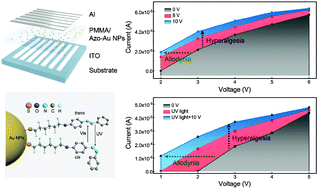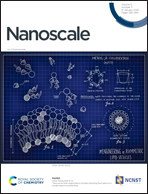A UV damage-sensing nociceptive device for bionic applications†
Abstract
Artificial limbs have been widely investigated in the past several decades, and multifuncional bionic limbs have already been constructed. However, due the lack of nociceptive systems, amputees still cannot feel ubiquitous noxious stimuli through bionic limbs. The construction of artificial nociceptors can bring bionic limbs closer to real flesh and bone. In daily life, UV irradiation is an invisible potential noxious stimulus to human skin and eyes. Furthermore, it is well known that the synthetic polymers widely used in bionic limbs can be degraded by UV radiation, accelerating their aging. Based on the above, UV damage-sensing nociceptors could be a feasible strategy to solve these existing problems. Here, azobenzene-functionalized gold nanoparticles (Azo-Au NPs) are embedded in insulating poly(methyl methacrylate) (PMMA) to construct a two-terminal memristor. With UV irradiation as a light damage medium, major nociceptive behaviors such as “threshold”, “relaxation” and “sensitization” are successfully emulated, demonstrating its potential application as a nociceptive system.

- This article is part of the themed collection: 2020 Nanoscale HOT Article Collection


 Please wait while we load your content...
Please wait while we load your content...